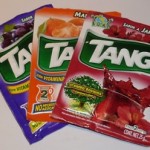Weekly Wrap: Volume 13
 Tang was Not Invented for the Space Program
Tang was Not Invented for the Space Program
In fact, Tang was actually invented by chemist and occasional playwright William A. Mitchell in 1957 while he was working for General Foods. General Foods introduced Tang to the public in powder form in 1959, but it wasn’t popular initially. This changed when NASA decided to use it in 1962 during John Glenn’s Mercury flight and later in 1965 during the Gemini program. According to an engineer… (more)
 Welch’s Grape Juice Started Out as a Substitute for Sacramental Wine
Welch’s Grape Juice Started Out as a Substitute for Sacramental Wine
You’ve probably heard about Jesus turning water into wine, but Dr. Thomas Bramwell Welch is a lesser-known drink magician who developed a way to turn something that would have been wine into a non-alcoholic version of the drink, in an attempt to make an “unfermented sacramental wine”. Dr. Welch was a physician, a dentist and a Methodist minister in Vineland, New Jersey. At the time, Methodists were strongly opposed to the consumption… (more)
 How the Cold War Started and Ended
How the Cold War Started and Ended
One of the earliest marked events of the Cold War arose from the anti-Communism remarks of British leader Winston Churchill. On March 5, 1946, in a famous speech characteristic of the political climate of the time, he said, “From Stettin in the Baltic to Trieste in the Adriatic an “Iron Curtain” has descended across the continent. Behind that…” (more)
 The Origin of the Words “Crayola” and “Crayon”
The Origin of the Words “Crayola” and “Crayon”
The word “Crayola” was originally thought up by Alice Binney. Binney, a one-time school teacher, combined the French word “craie”, meaning “chalk”, with “ola”, shortened from the French word “oléagineux”, meaning “oily”. Craie is also where “crayon” gets its leading “cray”, though the word “crayon” existed long before Crayola crayons were invented. It first appeared around the 16th… (more)
 Doctors are Not Bound by the Hippocratic Oath, Thankfully
Doctors are Not Bound by the Hippocratic Oath, Thankfully
A binding agreement, as much a social contract as Social Security or Medicare, the traditional Hippocratic Oath holds those who swear to it to a strict code of professional and personal conduct. Contrary to popular belief, though, most doctors never take this oath, and, actually, most of us are probably glad they never do. Although scholars disagree about when it was written, or even who wrote it, the general consensus is that the Hippocratic Oath was penned about 2500 years ago. Most commonly attributed to Hippocrates, the father of modern medicine… (more)
Bonus Quick Facts:
- “Here Come Dots” is an anagram of “The Morse Code”
- The film “The Day After Tomorrow” could have been more succinctly titled “Overmorrow”, which is the English word for the day after tomorrow, first popping up in English in 1535.
- The 2002 movie, Russian Ark, (96 minutes long with the plot spanning 3 centuries of Russian history) was filmed in its entirety in one take using 33 rooms of the Russian State Hermitage Museum. Over 2,000 people appeared in the film, and 3 orchestras were used.
- You may have heard that the “Daleks” in Dr. Who got their name from the Serbo-Croatian “dàlek”, meaning “far” or “distant”. But Terry Nation stated this is just a happy coincidence and that he came up with the name simply by pressing several random keys on his typewriter. The species themselves, in terms of behavior, he attempted to model after the Nazis.
- Have you ever suddenly jerked awake just as you are drifting off to sleep? This is called a “hypnic jerk” and also a “hypnagogic jerk”.
- The Fugates were a family that lived in Kentucky that had a rare condition known as Methemoglobinemia. Among other things, this hereditary genetic disorder results in the person’s skin appearing a very vivid shade of blue.
- The two women behind “Ask Ann Landers” and “Dear Abbey” were feuding twin sisters- Esther Lederer and Pauline Phillips respectively. The source of their dispute was reportedly the fact that after Esther took over the Ann Landers column in 1955 (with the original writer being Ruth Crowley from 1943-1955), Pauline decided to start up her own competing column with the same theme, “Dear Abby”. However, they supposedly settled their differences shortly before Esther died in 2002.
- While it isn’t clear where the word came from, the word “slut” first popped up in English meaning “slovenly” or “messy” around the 14th century and by the 15th century had started to be used to describe promiscuous women as well, and later ugly women. In the 19th century in England, “slut” still retained something of its original meaning, even so far as garbage cans being called “slut-holes”, meaning a hole for rubbish. Much more recently, Helen Fielding in Bridget Jones’s Diary used the word “slut” with its original meaning, “Check plates and cutlery for tell-tale signs of sluttish washing up…”, so the original meaning is still around, albeit much less commonly used now than the “promiscuous” definition.
- The word ‘desert’, as in “to get what is coming to you”, has been used in English since around the 13th century. However, this word has fallen out of common usage and now, outside of the idiom “just desert”, is almost never used, leading to many people mistakenly thinking it’s “just desserts” instead of the correct “just deserts”.
Other Interesting Stuff:
 Why Squinting Helps You See Better
Why Squinting Helps You See Better
Squinting causes two reactions that help you visualize the world around you in better detail. First, it changes the shape of our eye, allowing light to be focused better. Secondly, it decreases the amount of light that is allowed to enter the eye. Light coming from a limited number of directions allows that light to be more easily focused. If all that seems a bit vague, it is. To completely understand why these two reactions help us see better, let’s take a more in depth look at vision, light,… (more)
School buses are the primary mode of student transportation in North America. An estimated twenty-six million students in the United States alone are transported to school every school day via bus—over half the student population in the country. While school buses in countries outside of North America usually look like any other buses, North American school buses are distinctive for their yellow colour. It wasn’t always that way… (more)
 The Color Pink Doesn’t Exist? So Why Can We See It?
The Color Pink Doesn’t Exist? So Why Can We See It?
Absent from the visible spectrum and neither a wave nor a particle, the color pink is, for many, a scientific enigma: how can a shade that doesn’t even appear in the rainbow exist? The answer lies in color theory. Unlike art production (see below), when it comes to eyesight (and video production), the primary colors are red, green and… (more)
You Might Have Missed:
| Share the Knowledge! |
|





